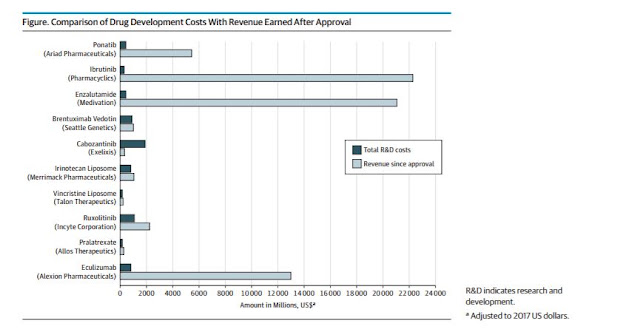Today's Managing Health Care Costs Number is $648 million |
Source Dark bars are R&D costs, while lighter bars are revenue. One of 9 medications has not yet paid back its R&D costs
JAMA Internal Medicine published an analysis of the cost of bringing a new cancer drug to market yesterday - and the cost is only 1/3 of what researchers at Tufts had previously estimated. The researchers used SEC filings for 10 small companies which had no drugs on the market in 2007 - and divided the reported research and development costs of each company by the number of approved drugs to estimate total R&D cost. The median estimated R&D cost was $648 million.
The payoffs for these companies was enormous. Total estimated R&D costs were $7.2 billion ($9.2 billion with discounting), and revenue for these drugs was $67 billion - and that revenue will continue for years to come.
This methodology to estimate research and development costs is not perfect. It could substantially underestimate the cost to the extent that the researchers are only including companies that succeeded. Many potential oncology drugs fail - and thus the researchers would not have been poring through their company's SEC 401K filings. Further, companies expend resources on activities other than research to bring a drug to market. On the other hand, the analysis doesn’t account for tax benefits for R&D - which lower the cost substantially.
Most of the cost of developing new drugs is not due to regulations - and is especially not due to "excess regulation". Half of these new medications were approved through the FDA's expedited process. These drugs are indicated for small populations, so the FDA accepted studies that were small for their approval.
The New York Times has an article on its current electronic front page asserting that the $475, 000 cost of Kymriah will be the norm for gene therapy. The article notes that there are 34 gene therapy drugs in the pipeline, and 470 in initial clinical trials.
This research on the cost of new drug development helps show that such high prices are not "necessary" to support research and development. But the pharmaceutical companies will continue to charge these high prices as long as they are able to. We clearly need ceiling prices, barriers to approval based on initial price, or system-wide price negotiations if we don't want to see pharmaceutical costs continue to drive lack of health care affordability.

EmoticonEmoticon